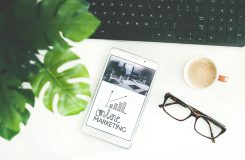The digital marketing strategy is one of the highly comprehensive and important tools for businesses. One of the essential features of any digital marketing strategy is accessibility. But very few companies know about digital accessibility.
Digital accessibility covers all about offering the full experience of the brand to different customers irrespective of their special needs. Let us explore digital accessibility and how it matters in the digital marketing strategy of any business. Starting with what is accessibility in digital marketing.
What is Accessibility in Digital Marketing?
Accessibility in digital marketing includes the different design practices that make it easy for people with special abilities to get the best out of the brand. Hence, it is a crucial step to ensure that everyone can enjoy the services, products, and brand.
The secret behind the accessibility in digital marketing is the expansion in the reach of the business product and services to potential customers. Further, it has a positive impact on the customers that the brand is doing enough for the people with special abilities. Businesses from certain areas must comply with regional accessibility standards.
Digital accessibility ensures that every person has a similar access to the content which remains to be the king in digital marketing. But which types of disabilities are catered to by digital accessibility?
Disabilities Handled by Digital Marketing Accessibility
People with the following disabilities the best benefited from digital marketing accessibility:
-
Learning
It covers memory loss or learning disabilities.
-
Thinking
This includes Alzheimer’s, Parkinson’s, and other mental illnesses including loss of mental function.
-
Communication
It covers the inability to talk or speech impairment.
-
Movement
This includes loss of a limb, paralysis, and limited movement due to different issues.
-
Hearing
It covers hearing loss or deafness.
-
Vision
This includes people having difficulty seeing or blindness.
Examples of Accessible Marketing
After having a quick overview of accessibility in digital marketing, time to have an overview of its successful examples:
-
Inclusive Experiences
Any digital marketing strategy should be equally accessible to offline and online users. It confirms and restricted use of the digital marketing initiatives for attracting business through both channels.
-
Email Marketing Accessibility
Email campaigns can be made highly accessible with the inclusion of certain features. These include proper headings, alt text, descriptive subject lines, and plain text versions.
-
Social Media Accessibility
The guidelines for social media accessibility are offered by the prestigious Princeton University. It focuses on making social media content highly accessible for people with special abilities. These guidelines are valid for audio, visual, text, and image content.
-
Video Content Accessibility
The accessible videos are viewed more by the audience. Hence, many businesses prefer to add captions and transcriptions in their video to make them highly accessible. Some other features include adding music or sound effects.
-
Content Accessibility
It ensures easy readability and optimized SEO benefits to businesses. The use of proper heading tags, sub-headings, headlines, and lists facilitates easy reading and scanning. The use of descriptive link text and accessible file uploading increases content accessibility. For social media content, it is easier to include that descriptive image text in the post.
-
Web Design Accessibility
Web design accessibility is an eternal part of digital marketing accessibility for any business. It includes a selection of the perfect fonts, improved navigation, and optimized call-to-action (CTA) buttons. Many prefer to go with the Sans serif font as these are easiest to read with no ornaments. The font size of 12 is good for readability. The use of keywords can facilitate web navigation.
These include using them in menus and buttons on your web page. The CTA should be accessible for a quick click by the users.
-
Image and Graphic Design Accessibility
The audience which is unable to see should be able to understand the image and graphic design in the digital marketing content. It is ideal for situations when the audience is having visual issues or the website is not loading properly.
Some of the common methods to ensure immediate graphic design accessibility in your digital marketing strategy are infographics, complementing colors, and adding alt text. All the infographics should be exported as PDFs as images can’t be read by different assistant devices.
It is important to use different design elements using the text and buttons to eliminate the color issues for the audience having color blindness or low vision. Some other methods are using different border patterns or sizes to communicate the content.
The alt text improves the overall SEO initiatives with the addition of at least one keyword in the total content images. It makes people understand the image when it is not displayed to them or they are unable to see it.
Requirements for Digital Accessibility (web accessibility)
Web accessibility is governed by the World Wide Web Consortium (W3C) and Web Content Accessibility Guidelines (WCAG). These offer single and standard requirements for the digital accessibility of the websites. According to them, any website should be:
-
Perceivable
Any website must be easily readable and easy to see by visually impaired persons.
-
Operable
Websites should be easy to operate and receptive.
-
Understandable
The information on the website should be easy to understand and present.
-
Robust
The website should be highly interactive with the different technology tools.
Importance of Accessibility in Digital Marketing
Before jumping to the importance of accessibility in digital marketing, it is essential to go through the main risks of inaccessibility.
With around 23 percent of people not using the internet from their digital devices, many businesses are missing their significant audience. A major factor for this figure is digital inaccessibility.
Some of the common risks for businesses due to accessibility in digital marketing initiatives include the following:
- Portraying a poor company reputation
- Legal actions due to non-compliance with the accessibility standards
- Failing to convert potential customers due to poor user experience
- Missing out on a large segment of the audience
Several businesses are leveraging the different benefits of digital accessibility. Some of the key points focusing on the importance of digital accessibility are:
-
Avoid Legal Issues
Firstly, it is easy for companies to avoid different lawsuits and complaints related to accessibility issues. Countries have strict laws protecting the interest of the differently abled paper. Hence, if you are not compliant with your regional accessibility standards, then you may attract legal issues.
The best solution in this case is to comply with the regional accessibility guidelines and the standard accessibility guidelines. You may standardize your website with W3C and WCAG guidelines.
-
Increases Branding
The key purpose of digital accessibility is to increase the overall business branding. There is no secret to understanding that customers would like to buy from a branch that takes care of differently-abled people.
It not only increases the business marketing initiatives toward a specific section of the audience but creates a long-lasting impact on others also. Customers are in love with brands that care about their special needs.
-
Increases Search Engine Rankings
Achieving high search engine rankings is the pain point of many digital marketers. Google indexes rely on text to understand images and media content. Hence, there is no better way than including digital accessibility in increasing the search engine rankings of your website.
You can go for adding alt text to videos and images. Thus, the Google algorithm will find your content easily and make it rank above inaccessible content.
-
Increases Return on Investments
Who doesn’t want to increase return on investments when it comes to digital marketing strategy? The best method to increase the return on investment is to see the help of digital accessibility.
Many businesses argue that the costs associated with digital accessibility may or may not balance their returns. However digital accessibility, when planned precisely, can easily bring amazing returns on investments.
-
Increases Usability
Your business website is not usable unless it is accessible to the people. Thus, it is important to take care of the users with different limitations like movement, hearing, vision, understanding, and others.
A clean and simple website prepared using accessibility standards is all that you need to make your business website a success.
Best Practices to Include Accessibility in Digital Marketing
Moving ahead in your exploration of accessibility in digital marketing, below are some of the best practices to include it:
-
Including Accessible Designs
Firstly, less is more when it comes to accessible web page designs. So, all you need to do is avoid complexity and prefer simplicity in the different digital marketing initiatives. You must take care of the special needs of people with special abilities according to their types of impairments.
-
Offering Transcripts and Captions for Videos
The video and audio content can be quickly made available to people with special abilities using the transcript. The captions along with a time-stamped transcript offer a detailed description of the video. All you need to do is ensure that the transcripts and captions are effective and highly accurate. This helps people with vision and hearing problems to understand the context of videos.
-
Including Screen Reader Coding
People with special abilities use screen readers for your web page content. Hence, it is essential to include the coding for this assistive technology on your web page. These assistive tools are highly useful for people with cognitive reading, or visual disorders. It is one of the important steps in including accessibility in your digital marketing.
-
Including Proper Contrast Ratio
Nobody wants to be on a web page having a drastic contrast ratio. Thus, all you need to do is maintain the amount of contrast between the background and the foreground colors of your web page. According to the WCAG guidelines, text and images of the text can have a contrast of 4:5:1. Businesses can use different color contrast checkers available to maintain a suitable contrast ratio for their web pages.
-
Including Captions and Alt Text for Informational Graphics and Images
It is essential to add alt text for different images and graphics. It is highly beneficial in cases when your web page is not loading or is viewed by people with vision impairment. Alt text should be accurate, descriptive, and have short details of the image offering its context with the content.
Concluding Thoughts
Thus, it is safe to conclude that accessibility matters in the digital marketing strategy. It is all about reaching the unreached audience by making your content accessible to the mass. There are different types of accessibility like website accessibility, email accessibility, video accessibility, content accessibility, and many more. The W3C and WCAG standards offer the best standards for website accessibility.
It is easy to understand the importance of accessibility in marketing and the best practices to include it. So, all you need to do is keep accessibility in mind while taking any big or small step in your digital marketing strategy.


















